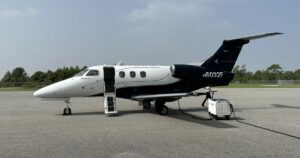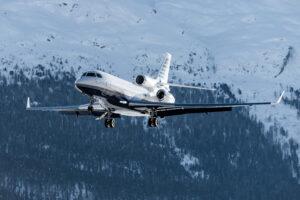- Private jets can reach higher altitudes due to higher power-to-weight ratio.
- Private jets have unique safety systems for cabin pressurisation and descending faster.
- Flying at higher altitudes increases efficiency due to lower fuel consumption and less air traffic.
Most large commercial aircraft cruise at an altitude between 30,000 feet and 40,000 feet. Many have a service ceiling (maximum permitted altitude) slightly higher than that, but don’t usually reach it. Smaller private and business jets, however, regularly cruise at altitudes of up to 51,000 feet. There are several reasons why they do this.
1/ Because They Can
Private jets are relatively smaller and lighter
- Higher power-to-weight ratio
- Greater rate of climb
- Lighter and smaller
- Shorter wingspans
The first point to make here is that private jets can reach and operate at these higher altitudes more easily. In general, private jets have a higher power-to-weight ratio, allowing them to ascend faster and maintain higher speed at higher altitudes. Commercial aircraft on the other hand, will be much heavier (even relative to their size) with passengers and payload.

The Gulfstream G650 can fly at an altitude of 51,000ft
Wingspan is also (relatively) lower, which impacts performance at altitude. To reach higher altitudes economically, commercial aircraft would need much larger wing areas. Innovations such as the longer wings for the Boeing 777X (which fold on the ground) are to help efficient performance.
2/ Saves Time and Money
Flying at higher altitudes is faster and more efficient
Very Light Jets: Approximate fuel consumption is 77 to 87 gallons per hour.
Light Jets: Approximate fuel consumption is 100 to 125 gallons per hour.
Midsize Jets: Approximate fuel consumption is 150 to 280 gallons per hour.
Large Jets: Approximate fuel consumption is 300 to 500 gallons per hour.
Reaching these higher altitudes is desirable for better performance (if commercial aircraft could, they probably would). At higher altitudes, the air is thinner, which results in lower fuel consumption. This, of course, needs to be balanced against the fuel burn required to climb to altitude (which again is more of a consideration for a much heavier commercial aircraft).

The Embraer Phenom 100 – the most economical jet in its class, with a second-hour fuel burn of just 77 gph
Engines are important here as well. Jet engines also operate more efficiently at higher altitudes. In particular, the bypass ratios of engines in private jets are designed to optimise performance.
3/ Less Congestion
There is less air traffic at higher altitude
Another major consideration is air traffic. With all commercial traffic operating at similar altitudes and along the same flight paths, private jets have more flexibility. Flying at a different, and less congested, altitude makes flight planning easier and allows for more direct routes. There is also less chance of having to make changes or facing delays on desired routes.
As private jet travel is largely about convenience and flexibility, this is an important benefit. Planning is easier, flight time can be lowered, and costs less as a result. This is something that benefited Concorde in its operations as well.
4/ A Comfortable Experience
Higher altitude makes for a smoother flight
Intensity
- Light: Slight erratic changes in altitude and/or attitude
- Moderate: Change in altitude and/or attitude, but the aircraft remains in positive control at all times
- Severe: Large, abrupt changes in altitude and/or attitude. Aircraft may be momentarily out of control
- Extreme: Aircraft is violently tossed about and practically impossible to control. May cause structural damage.
Weather and turbulence are another consideration. At 35,000 feet, commercial aircraft are already well out of the way of the worst conditions, but occasional or strong turbulence can still be a problem. This becomes less of a problem at higher altitudes.
In addition, in the event of encountering or approaching poor weather or turbulent conditions, the lower volume of air traffic makes it easier to change routes and avoid the worst conditions.
5/ How High Are we Talking About?
As high as 51,000 feet
Most commercial aircraft fly at around 35,000 feet (with different levels specified by air traffic control throughout the route), and are rated to fly at up to 41,000 feet. Some widebody aircraft are rated higher – such as the Airbus A380. The Airbus A350 and Boeing 787 are all rated up to 43,100 feet (with the larger 787-10 and A350-1000 rated lower at 41,100 feet and 41,450 feet). With air traffic restrictions, though, they may not usually fly this high.
All medium and large private jets are capable of operating higher than this and usually do. With less traffic and air traffic restrictions, operators are more free to set desired altitudes. The highest ratings of 51,000 feet are in place for many aircraft – including the Gulfstream G650 and G650ER, Bombardier Global Express jets, Cessna Citation X, and the Dassault Falcon 7X. Embraer Legacy and Praetor jets, as well as the Cessna Citation Longitude and Excel jets, are all rated lower at 45,000 feet.

The Falcon 7X has one of the world’s highest altitude ratings